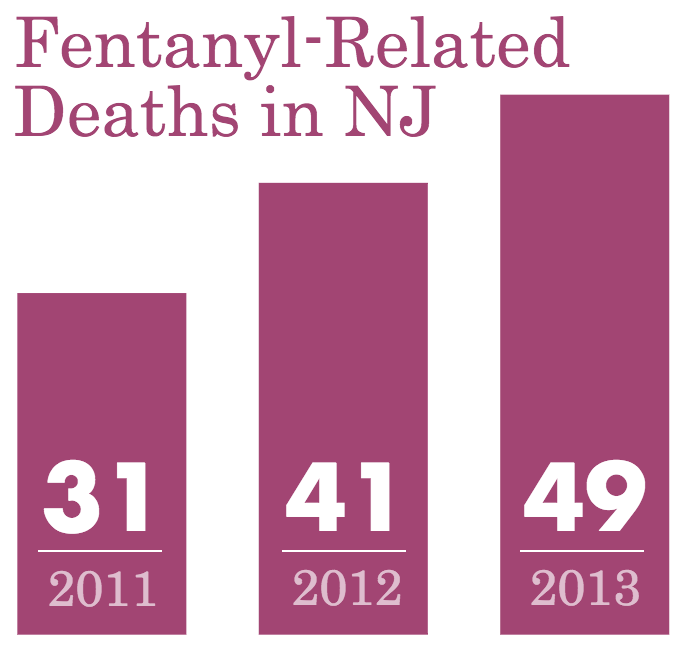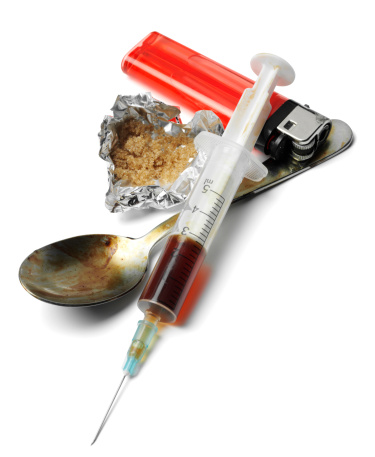The already drug-plagued Garden State has discovered a new and deadly roadblock in its ongoing struggle to curb addiction and substance abuse: fentanyl. A powerful prescription opioid, which is available in doses up to 50 times more powerful than heroin, fentanyl\’s clinical use is to treat patients with severe chronic pain and extreme medical conditions, such as advanced-stage cancer.
The latest available state data reveals that fentanyl has killed 144 New Jersey residents between 2011 and 2013.[1] Heroin sold in New Jersey is often cut with fentanyl without users even realizing it, something that has led to more hospital admissions and fatalities in the state. While heroin abuse has long been a problem in the Garden State, being responsible for over 5,000 deaths since 2004, the rise of fentanyl laced heroin presents a much more dire situation.[2]
 Drug users and abusers are at a higher risk of overdose and other adverse drug effects when they do not know what they\’re purchasing. Part of the problem is the lack of ability to treat overdose victims. While Narcan, an extremely effective and highly used opioid-overdose remedy, has saved hundreds of lives since 2014, it is ineffective in treating overdoses from some of the lethal drug mixtures state police have recently seized, such as “Power Hour,†“Taliban†and “Strike Dead.â€[3]
Drug users and abusers are at a higher risk of overdose and other adverse drug effects when they do not know what they\’re purchasing. Part of the problem is the lack of ability to treat overdose victims. While Narcan, an extremely effective and highly used opioid-overdose remedy, has saved hundreds of lives since 2014, it is ineffective in treating overdoses from some of the lethal drug mixtures state police have recently seized, such as “Power Hour,†“Taliban†and “Strike Dead.â€[3]
While it\’s unclear whether the seized drugs, which were found in stamped wax folds (similar to how heroin is sold), were being marked as heroin or contained fentanyl, it was determined that some contained no heroin at all and others only contained traces. This begs the question: if there was no heroin, what drugs did users think they were taking?
A Growing National Health Problem
The Garden State is not the only area of the nation that has been hit particularly hard with the rise of fentanyl. The last time fentanyl became a problem, between 2005 and 2007, there were over 1,000 fentanyl related deaths nationally. Its reemergence as an addiction threat has already begun taking its toll around the country.
nationally. Its reemergence as an addiction threat has already begun taking its toll around the country.
- Officials reported over 200 fentanyl related deaths in Pennsylvania during 2014.
- In Erie County, NY, there were 32 deaths involving Fentanyl in 2013; it was involved in 23 percent of the 139 chemical intoxication deaths in the county.
- In 2014, of the 280 drug related deaths in New Hampshire, fentanyl was the most common contributing drug found, at 102.
- In 2014, there were 3,344 drug busts involving fentanyl nationwide, up from just 942 in 2013.
- More than three dozen deaths have occurred in Maryland involving the combination of heroin and fentanyl since September 2014.
The worsening problem of fentanyl-laced heroin overdoses prompted the United States Drug Enforcement Administration to issue a nationwide health and public safety alert in March of 2015:
“Drug incidents and overdoses related to fentanyl are occurring at an alarming rate throughout the United States and represent a significant threat to public health and safety,†said DEA Administrator Michele M. Leonhart in the press release. “…Fentanyl is extremely dangerous to law enforcement and anyone else who may come in contact with it.â€[4]
Lack of Drug Prevention Resources
While the drug first started figuring prominently in New Jersey since 2005, state officials admit that poor communication and lack of infrastructure kept it off their radar until very recently.
Some lament the lack of state-sanctioned protocol regarding the reporting of overdoses to the authorities and emergency responders. There is currently legislation in place to give officials the power and resources to combat fentanyl and other drugs; The latest available state data reveals that fentanyl has killed 144 New Jersey residents between 2011 and 2013.
however, there is no movement as of yet. Illicit-grade fentanyl can be easily made, and the Center for Disease Control and Prevention reports that one gram of pure fentanyl can be parsed into 7,000 doses for sale on the street.
A Closer Examination of the History and Dangers of Fentanyl
 Originally manufactured in the 1960s and introduced to the consumer market in the 1990s, fentanyl was intended to be a drug with immense painkilling powers; far more potent than morphine and other opioids. It is commonly used in hospitals for anesthesia, surgery and in intensive care units. It is also useful as a long-term pain management remedy and in the treatment of chronic conditions. It works by attaching to the brain\’s opiate receptors and increasing levels of dopamine, a natural hormone that creates happiness and euphoria.
Originally manufactured in the 1960s and introduced to the consumer market in the 1990s, fentanyl was intended to be a drug with immense painkilling powers; far more potent than morphine and other opioids. It is commonly used in hospitals for anesthesia, surgery and in intensive care units. It is also useful as a long-term pain management remedy and in the treatment of chronic conditions. It works by attaching to the brain\’s opiate receptors and increasing levels of dopamine, a natural hormone that creates happiness and euphoria.
One of the biggest problems with the drug is how strong it is. At up to 100 times the strength of morphine, its potency makes individuals susceptible to overdose even when using small amounts. This potency makes it difficult for drug dealers to effectively dilute the drug, potentially leading to extremely dangerous drug concoctions.
On the street, fentanyl is known as China White, Apache and King Ivory, among several other monikers. In prescription form, common brand names include Sublimaze, Duragesic, Actiq and Fentora. Side effects from usage encompass nausea, drowsiness, constipation, dry mouth, dizziness, sweating and fatigue.
In medical settings, fentanyl is the most widely used opioid in clinical medicine. It is most often administered as a patch (slowly releasing the drug) or orally. When involved in illicit use, fentanyl is frequently injected, smoked or snorted as a combination with heroin or cocaine. It is highly addictive and its withdrawal symptoms mirror those associated with other opioids.
Signs of Fentanyl Abuse and Addiction
 Due to the medical nature of fentanyl, sustaining an addiction to the drug usually requires criminal activity, such as theft, prescription fraud or doctor shopping. When acquired through street drug dealers, use is even more dangerous, as the line between therapeutic and fatal fentanyl use is very slim, and unknown amounts are often cut with heroin and cocaine to produce more euphoric effects.
Due to the medical nature of fentanyl, sustaining an addiction to the drug usually requires criminal activity, such as theft, prescription fraud or doctor shopping. When acquired through street drug dealers, use is even more dangerous, as the line between therapeutic and fatal fentanyl use is very slim, and unknown amounts are often cut with heroin and cocaine to produce more euphoric effects.
Like any addiction, signs can be found in a person\’s lifestyle, mood and behavior. Signs of fentanyl abuse are similar to those found in abuse of other opioids:
- Elevated or depressed mood
- Increased anxiety
- More and more of the drug is taken progressively
- Use continues despite knowledge of detrimental effects
- Use interferes with work and family responsibilities
Causes of abuse and addiction are generally either genetic, social, psychological or for self- medication. As with all addictions, the condition must be treated concurrently with the root cause(s) of addiction and continued abuse.



